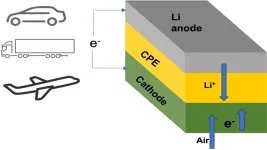(Press-News.org) PULLMAN, Wash. -- An air filter made out of corn protein instead of petroleum products can concurrently capture small particulates as well as toxic chemicals like formaldehyde that current air filters can’t.
The research could lead to better air purifiers, particularly in regions of the world that suffer from very poor air quality. Washington State University engineers report on the design and tests of materials for this bio-based filter in the journal Separation and Purification Technology.
“Particulate matter is not that challenging to filter but to simultaneously capture various kinds of chemical gas molecules, that’s more significant,” said Katie Zhong, professor in WSU’s School of Mechanical and Materials Engineering and a corresponding author on the paper. “These protein-based air filtering materials should be very promising to capture multiple species of air pollutants.”
Poor air quality is a factor in diseases such as asthma, heart disease and lung cancer. Commercial air purifiers remove tiny particles in soot, smoke or car exhaust, which could be inhaled directly into the lungs, but air pollution also often contains other hazardous gaseous molecules, such as carbon monoxide, formaldehyde and other volatile organic compounds.
With micron-sized pores, typical high efficiency particulate air filters, also known as HEPA filters, can capture the small particles but aren’t able to capture gaseous molecules. They are most often made of petroleum products and glass, which leads to secondary pollution when old filters are thrown away, Zhong said.
The WSU researchers developed a more environmentally friendly air filter made from corn protein fibers that was able to simultaneously capture 99.5% of small particulate matter, similar to commercial HEPA filters, and 87% of formaldehyde, which is higher than specially designed air filters for those types of toxics.
The researchers chose corn to study because of its abundance as an agricultural product in the U.S. The corn protein is also hydrophobic, which means that the protein repels water and could work well in a moist environment such as in a mask.
The amino acids in the corn protein are known as functional groups. When exposed at the protein's surface, these functional groups act like multiple hands, grabbing the toxic chemical molecules. The researchers demonstrated this by exposing a functional group at the protein surface, where it grabbed formaldehyde. They theorize that further rearrangement of the proteins could develop a tentacle-like set of functional groups that could grab a variety of chemicals from the air.
“From the mechanism, it’s very reasonable to expect that this protein-based air filter could capture more species of toxic chemical molecules,” Zhong said.
The three-dimensional structure that they developed also offers more promise for a simple manufacturing method than thin films of proteins that the research team developed previously. They used a small amount of a chemical, polyvinyl alcohol, to glue the nanofibers together into a lightweight foam-like material.
“This work provides a new route to fabricating environmentally friendly and multi-functional air filters made from abundant natural biomass,” Zhong said. “I believe this technology is very important for people’s health and our environment, and it should be commercialized.”
The researchers would like to do more testing, including using a variety of functional group structures and other toxic chemical molecules. In addition to Zhong, the work was conducted by graduate student Shengnan Lin, Ming Luo, Flaherty assistant professor in the WSU School of Mechanical and Materials Engineering, and post-doctoral fellow Xuewei Fu. The work was funded by a U.S. Department of Agriculture Sun Grant.
END
Novel air filter captures wide variety of pollutants
2023-02-23
ELSE PRESS RELEASES FROM THIS DATE:
Patients with high blood pressure who partnered with community health workers more likely to achieve blood pressure control
2023-02-23
Patients with hypertension paired with a community health worker (CHW) through their primary care practice were more than three and a half times as likely to achieve blood pressure control within six months compared to patients who were not. New research, led by researchers at NYU Grossman School of Medicine, suggest that similar CHW inventions could help other underserved, immigrant communities experiencing similar disparities.
Published online today in the journal Circulation: Cardiovascular Quality and Outcomes, the findings focus on community health workers (CHWs), lay members of a community who usually share ethnicity, language, income level, and/or life experiences with the people ...
Dr. Omar Abdul-Rahman named Chief of Division of Medical Genetics in Pediatrics at Weill Cornell Medicine and NewYork-Presbyterian Komansky Children’s Hospital
2023-02-23
Dr. Omar Abdul-Rahman, a leading specialist in pediatric genetic medicine, has been named chief of the Division of Medical Genetics in the Department of Pediatrics at Weill Cornell Medicine and NewYork-Presbyterian Komansky Children’s Hospital, effective March 1.
The Division of Medical Genetics provides inpatient and outpatient consultation and medical care for children and adolescents with common and rare genetic conditions, including screening and counseling for inherited disease risk during pregnancy. Dr. Abdul-Rahman, who was recruited ...
New treatment regimen may decrease mortality in patients with cardiotoxicity from immune checkpoint inhibitors
2023-02-23
Bottom Line: Among cancer patients who developed cardiotoxicity after treatment with immune checkpoint inhibitor (ICI) therapy, those treated with abatacept (Orencia), ruxolitinib, and/or mechanical ventilation as needed had a significantly lower mortality rate than those treated with standard-of-care corticosteroids.
Journal in Which the Study was Published: Cancer Discovery, a journal of the American Association for Cancer Research (AACR)
Author: Joe-Elie Salem, MD, PhD, a professor at Sorbonne Université, and executive assistant director of one of France’s Clinical Investigation Centers focused on cardio-metabolism
Background: Immune checkpoint inhibitors comprise ...
U.S. Department of Energy announces $68 million for small businesses developing technologies to cut emissions and study climate
2023-02-23
WASHINGTON, D.C.—The U.S. Department of Energy (DOE) today announced awards totaling more than $68 million that will go to 53 small businesses that are solving scientific problems. Projects include developing tools for climate research and advanced materials and technologies for clean energy conversion. Understanding the climate and the ability to convert and store energy are instrumental to meeting President Biden’s goal of a completely clean electrical grid by 2035 and net-zero greenhouse-gas emissions ...
Researchers identify breakthrough in understanding fentanyl abuse
2023-02-23
The ongoing opioid epidemic continues to take a heavy toll on American communities, with more than 80,000 opioid-related deaths reported in 2021, according to the National Institutes of Health. Despite the severity of this issue, the neurological mechanisms underlying opioid addiction, withdrawal and relapse are not fully understood.
A study recently published in Cell Reports sheds light on the subject. Jun Wang, associate professor in the Department of Neuroscience and Experimental Therapeutics at the Texas A&M University School of Medicine, and members ...
Simplified HIV treatment options just as effective: Major clinical trial
2023-02-23
(SEATTLE, Wednesday 22 February 2023) Two newer simplified treatment options are at least as effective as current approaches, according to the results of a world-first international clinical trial into second-line HIV therapy led by the Kirby Institute at UNSW Sydney and presented today at the Conference on Retroviruses and Opportunistic Infections (CROI) in Seattle.
Second-line treatment is the name given to the range of treatment options available to a person for whom the first HIV treatment offered to them does not work. Worldwide, this is about 10% of people ...
New design for lithium-air battery could offer much longer driving range compared with the lithium-ion battery
2023-02-23
Many owners of electric cars have wished for a battery pack that could power their vehicle for more than a thousand miles on a single charge. Researchers at the Illinois Institute of Technology (IIT) and U.S. Department of Energy’s (DOE) Argonne National Laboratory have developed a lithium-air battery that could make that dream a reality. The team’s new battery design could also one day power domestic airplanes and long-haul trucks.
The main new component in this lithium-air battery is a solid electrolyte instead of the usual liquid variety. Batteries with solid electrolytes ...
Parkinson’s disease patients experience significant reduction in symptoms with non-surgical focused ultrasound treatment
2023-02-23
VIDEOS: Interviews, B-Roll
https://www.dropbox.com/scl/fo/b1tpiamgunp5ekymyxaks/h?dl=0&rlkey=zk15bee6kru69ebryxaha0g3j
YouTube Video. Unlisted & only viewable w/ link until embargo lifts. https://youtu.be/Ceg7R3sw7Qs
Patients with Parkinson’s disease achieved a significant improvement in their tremors, mobility, and other physical symptoms after having a minimally invasive procedure involving focused ultrasound, according to a new study today published in the New England Journal of Medicine.
The clinical trial was led by researchers at the ...
UTA research explores how T-cells detect cancer
2023-02-23
A University of Texas at Arlington bioengineering professor is leading a state-funded project that will try to identify what T-cells are detecting in cancerous cells to better craft a personalized cancer immunotherapy.
George Alexandrakis received a $250,000 Cancer Prevention and Research Institute of Texas (CPRIT) grant titled “Ultrasensitive Nanosensor-Based Detection of Tumor Immunogenic Peptides to Enable Personalized Cancer Immunotherapy.”
“One of the challenges with cancer is that it is so variable. It changes all the time and is different in all people,” Alexandrakis said. ...
After 25 years of AI health tech research computers are slowly beginning to listen to patients
2023-02-23
Patients experiences of health conditions are slowly being integrated into healthcare AI studies, a review of 25 years of studies has found.
In a new paper published in Lancet Digital Health along with an associated opinion piece, experts from the University of Birmingham and University Hospitals Birmingham have looked at more than 600 interventional studies on AI healthcare technologies.
While the team, funded by the National Institute for Health and Care Research (NIHR), found that only 24% of studies have a patient reported outcome element included in their study, there has been an increase in the number in recent years with 2021 and 2022 seeing nearly two thirds of all studies ...


